Effect of Tool Design and Process Parameters on Lap Joints Made by Right Angle Friction Stir Welding (RAFSW)
Abstract
1. Introduction
2. Materials and Methods
3. Results and Discussion
3.1. Design of Experiments
3.2. Artificial Neural Network Modeling
3.2.1. Effect of Tool Geometry Parameters on the Welding Force and Tensile Shear Force
3.2.2. Effect of Process Parameters on the Welding Force and Tensile Shear Force
4. Conclusions
- The effect of tool design and process parameters on the quality of the lap joints and the generated forces during the RAFSW process were predicted with high accuracy using ANN modeling.
- Larger shoulder diameters and pin lengths caused an increase of the downward axial force and a decrease of the fracture force of the joints.
- The downward axial force and the fracture force of the joints increased with an increase of pin base diameter and pin lead. However, the variation of shoulder groove depth and pin angle had minor effects on the axial force and the failure force, in the studied range.
- The increase of the tool rotational speed caused a reduction of the downward axial force and the fracture force. The downward axial force increased and the fracture force decreased with an elevation of tool traverse speed and rotational speed.
- The efficient range for tool design and process parameters to make quality lap joints at good traverse speeds is provided in Table 9.
- Making quality lap joints at high traverse speed while keeping the downward axial force as low as possible is the most promising condition for industrial users. According to this study, one could accomplish a sound, quality AA6061-T6 lap joint made by the RAFSW technique at traverse speeds as high as 1400 mm/min and downward axial forces as low as 3.2 kN.
Author Contributions
Funding
Acknowledgments
Conflicts of Interest
References
- Mishra, R.S.; Ma, Z.Y. Friction stir welding and processing. Mater. Sci. Eng. R Rep. 2005, 50, 1–78. [Google Scholar] [CrossRef]
- Mishra, R.S.; Mahoney, M.W. Future Outlook for Friction Stir Welding and Processing. In Friction Stir Welding and Processing; Mishra, R.S., Mahoney, M.W., Eds.; ASM International: Materials Park, OH, USA, 2007; pp. 351–352. [Google Scholar]
- Nandan, R.; Debroy, T.; Bhadeshia, H.K.D.H. Recent advances in friction-stir welding—Process, weldment structure and properties. Prog. Mater. Sci. 2008, 53, 980–1023. [Google Scholar] [CrossRef]
- Gibson, B.T.; Lammlein, D.H.; Prater, T.J.; Longhurst, W.R.; Cox, C.D.; Ballun, M.C.; Dharmaraj, K.J.; Cook, G.E.; Strauss, A.M. Friction stir welding: Process, automation, and control. J. Manuf. Process. 2014, 16, 56–73. [Google Scholar] [CrossRef]
- Momeni, M.; Guillot, M. Development of friction stir welding technique at right angle (RAFSW) applied on butt joint of AA6061-T6 aluminum alloy. Int. J. Adv. Manuf. Technol. 2018, 99, 3077–3089. [Google Scholar] [CrossRef]
- Imani, Y. Development of Friction Stir Welding Techniques for Multi-Axis Machines. Ph.D. Thesis, Laval University, Quebec, QC, Canada, 2015. [Google Scholar]
- Pishevar, M.; Mohandesi, J.; Omidvar, H.; Safarkhanian, M. Influences of Friction Stir Welding Parameters on Microstructural and Mechanical Properties of AA5456 (AlMg5) at Different Lap Joint Thicknesses. J. Mater. Eng. Perform. 2015, 24, 3835–3844. [Google Scholar] [CrossRef]
- Silva, A.; Braga, D.; Figueiredo, M.; Moreira, P. Ultimate tensile strength optimization of different FSW aluminium alloy joints. Int. J. Adv. Manuf. Technol. 2015, 79, 805–814. [Google Scholar] [CrossRef]
- Wang, M.; Zhang, H.; Zhang, J.; Zhang, X.; Yang, L. Effect of Pin Length on Hook Size and Joint Properties in Friction Stir Lap Welding of 7B04 Aluminum Alloy. J. Mater. Eng. Perform. 2014, 23, 1881–1886. [Google Scholar] [CrossRef]
- Buffa, G.; Campanile, G.; Fratini, L.; Prisco, A. Friction stir welding of lap joints: Influence of process parameters on the metallurgical and mechanical properties. J. Mater. Sci. Eng. A 2009, 519, 19–26. [Google Scholar] [CrossRef]
- D’Urso, G.; Giardini, C. The influence of process parameters and tool geometry on mechanical properties of friction stir welded aluminum lap joints. Int. J. Mater. Form. 2010, 3, 1011–1014. [Google Scholar] [CrossRef]
- Liu, H.; Zhao, Y.; Hu, Y.; Chen, S.; Lin, Z. Microstructural characteristics and mechanical properties of friction stir lap welding joint of Alclad 7B04-T74 aluminum alloy. Int. J. Adv. Manuf. Technol. 2015, 78, 1415–1425. [Google Scholar] [CrossRef]
- Zhang, Y.N.; Cao, X.; Larose, S.; Wanjara, P. Review of tools for friction stir welding and processing. Can. Metall. Quar. 2012, 51, 250–261. [Google Scholar] [CrossRef]
- Costa, M.; Verdera, D.; Costa, J.D.; Leitao, C.; Rodrigues, D.M. Influence of pin geometry and process parameters on friction stir lap welding of AA5754-H22 thin sheets. J. Mater. Process. Technol. 2015, 225, 385–392. [Google Scholar] [CrossRef]
- Wang, T.; Sidhar, H.; Mishra, R.S.; Hovanski, Y.; Upadhyay, P.; Carlson, B. Effect of hook characteristics on the fracture behaviour of dissimilar friction stir welded aluminium alloy and mild steel sheets. Sci. Technol. Weld. Join. 2019, 24, 178–184. [Google Scholar] [CrossRef]
- Wang, K.; Upadhyay, P.; Wang, Y.; Li, J.; Sun, X.; Roosendaal, T. Investigation of Interfacial Layer for Friction Stir Scribe Welded Aluminum to Steel Joints. J. Manuf. Sci. Eng. 2018, 140, 111005. [Google Scholar] [CrossRef]
- Gupta, V.; Upadhyay, P.; Fifield, L.S.; Roosendaal, T.; Sun, X.; Nelaturu, P.; Carlson, B. Linking process and structure in the friction stir scribe joining of dissimilar materials: A computational approach with experimental support. J. Manuf. Proc. 2018, 32, 615–624. [Google Scholar] [CrossRef]
- Rai, R.; De, A.; Bhadeshia, H.K.D.H.; Debroy, T. Review: Friction stir welding tools. Sci. Technol. Weld. Join. 2011, 16, 325–342. [Google Scholar] [CrossRef]
- Yue, Y.; Li, Z.; Ji, S.; Huang, Y.; Zhou, Z. Effect of Reverse-threaded Pin on Mechanical Properties of Friction Stir Lap Welded Alclad 2024 Aluminum Alloy. J. Mater. Sci. Technol. 2016, 32, 671–675. [Google Scholar] [CrossRef]
- Yadava, M.K.; Mishra, R.S.; Chen, Y.L.; Carlson, B.; Grant, G.J. Study of friction stir joining of thin aluminium sheets in lap joint configuration. Sci. Technol. Weld. Join. 2010, 15, 70–75. [Google Scholar] [CrossRef]
- Movahedi, M.; Kokabi, A.H.; Reihani, S.M.S.; Najafi, H. Effect of tool travel and rotation speeds on weld zone defects and joint strength of aluminium steel lap joints made by friction stir welding. Sci. Technol. Weld. Join. 2012, 17, 162–167. [Google Scholar] [CrossRef]
- Yazdanian, S. Effect of friction stir lap welding conditions on joint strength of aluminium alloy 6060. IOP Conf. Ser. Mater. Sci. Eng. 2009, 4, 012021. [Google Scholar] [CrossRef]
- Rao, R.V. Advanced Modeling and Optimization of Manufacturing Processes International Research and Development; Springer: London, UK, 2011. [Google Scholar]
- Das, B.; Pal, S.; Bag, S. Torque based defect detection and weld quality modelling in friction stir welding process. J. Manuf. Process. 2017, 27, 8–17. [Google Scholar] [CrossRef]
- Okuyucu, H.; Kurt, A.; Arcaklioglu, E. Artificial neural network application to the friction stir welding of aluminum plates. Mater. Des. 2007, 28, 78–84. [Google Scholar] [CrossRef]
- Bayazid, S.M.; Farhangi, H.; Ghahramani, A. Investigation of Friction Stir Welding Parameters of 6063-7075 Aluminum Alloys by Taguchi Method. Procedia Mater. Sci. 2015, 11, 6–11. [Google Scholar] [CrossRef]
- Ghetiya, N.D.; Patel, K.M. Prediction of Tensile Strength in Friction Stir Welded Aluminium Alloy Using Artificial Neural Network. Procedia Technol. 2014, 14, 274–281. [Google Scholar] [CrossRef]
- Buffa, G.; Fratini, L.; Micari, F. Mechanical and microstructural properties prediction by artificial neural networks in FSW processes of dual phase titanium alloys. J. Manuf. Process. 2012, 14, 289–296. [Google Scholar] [CrossRef]
- Palanivel, R.; Laubscher, R.; Dinaharan, I.; Murugan, N. Tensile strength prediction of dissimilar friction stir-welded AA6351–AA5083 using artificial neural network technique. J. Braz. Soc. Mech. Sci. Eng. 2016, 38, 1647–1657. [Google Scholar] [CrossRef]
- Liu, F.C.; Ma, Z.Y. Influence of Tool Dimension and Welding Parameters on Microstructure and Mechanical Properties of Friction-Stir-Welded 6061-T651 Aluminum Alloy. Metal. Mater. Trans. A 2008, 39, 2378–2388. [Google Scholar] [CrossRef]

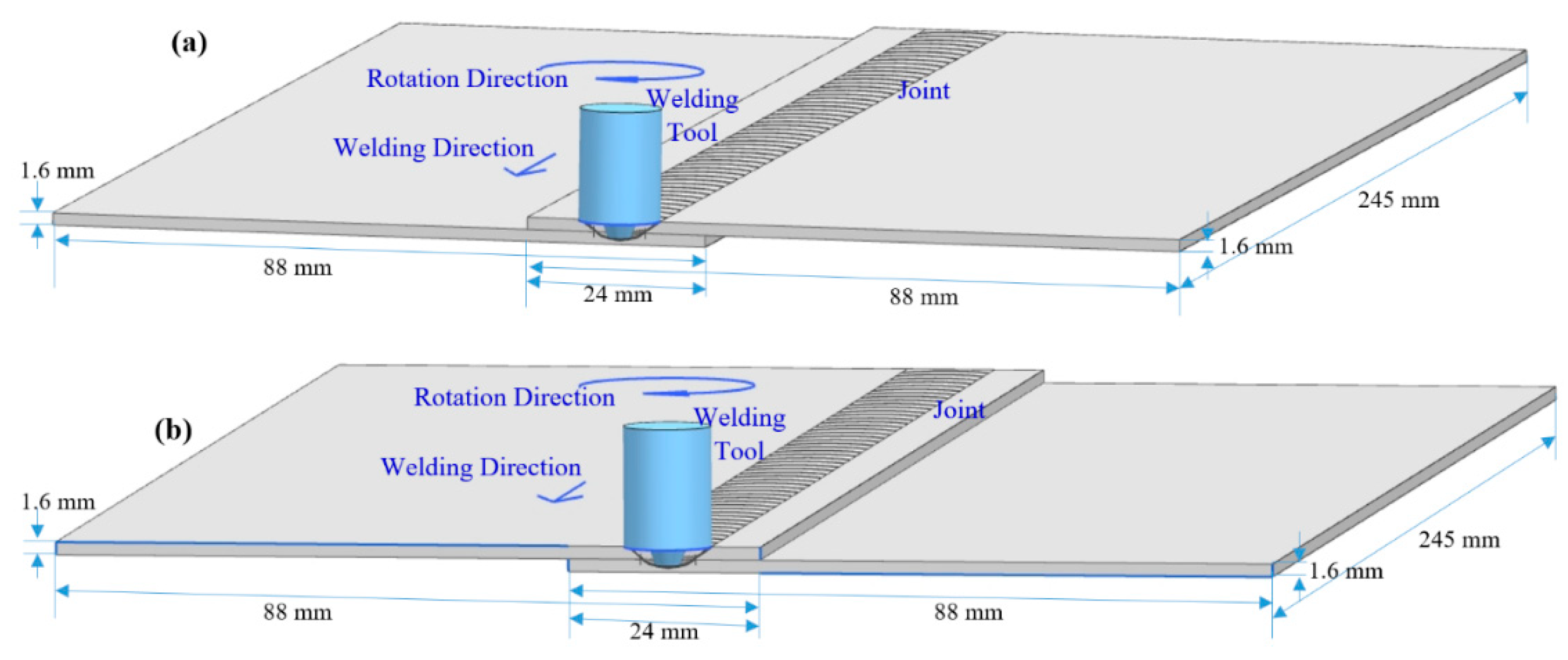
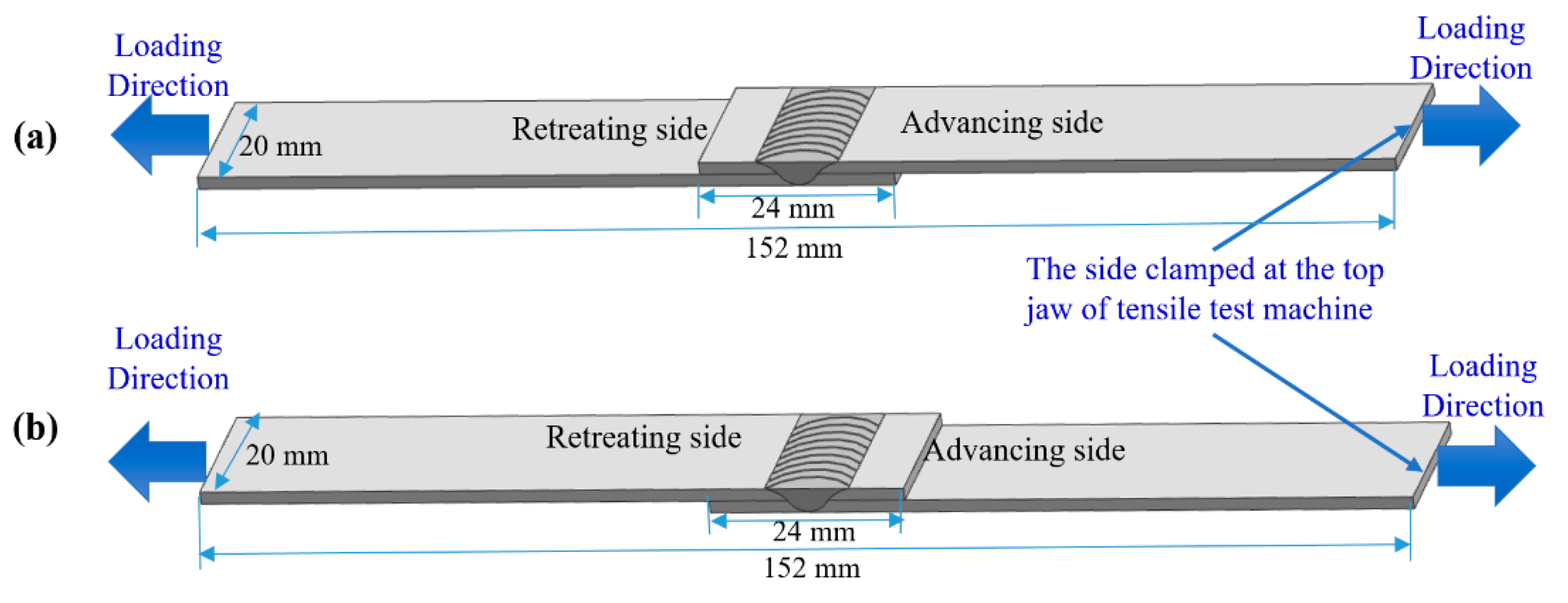
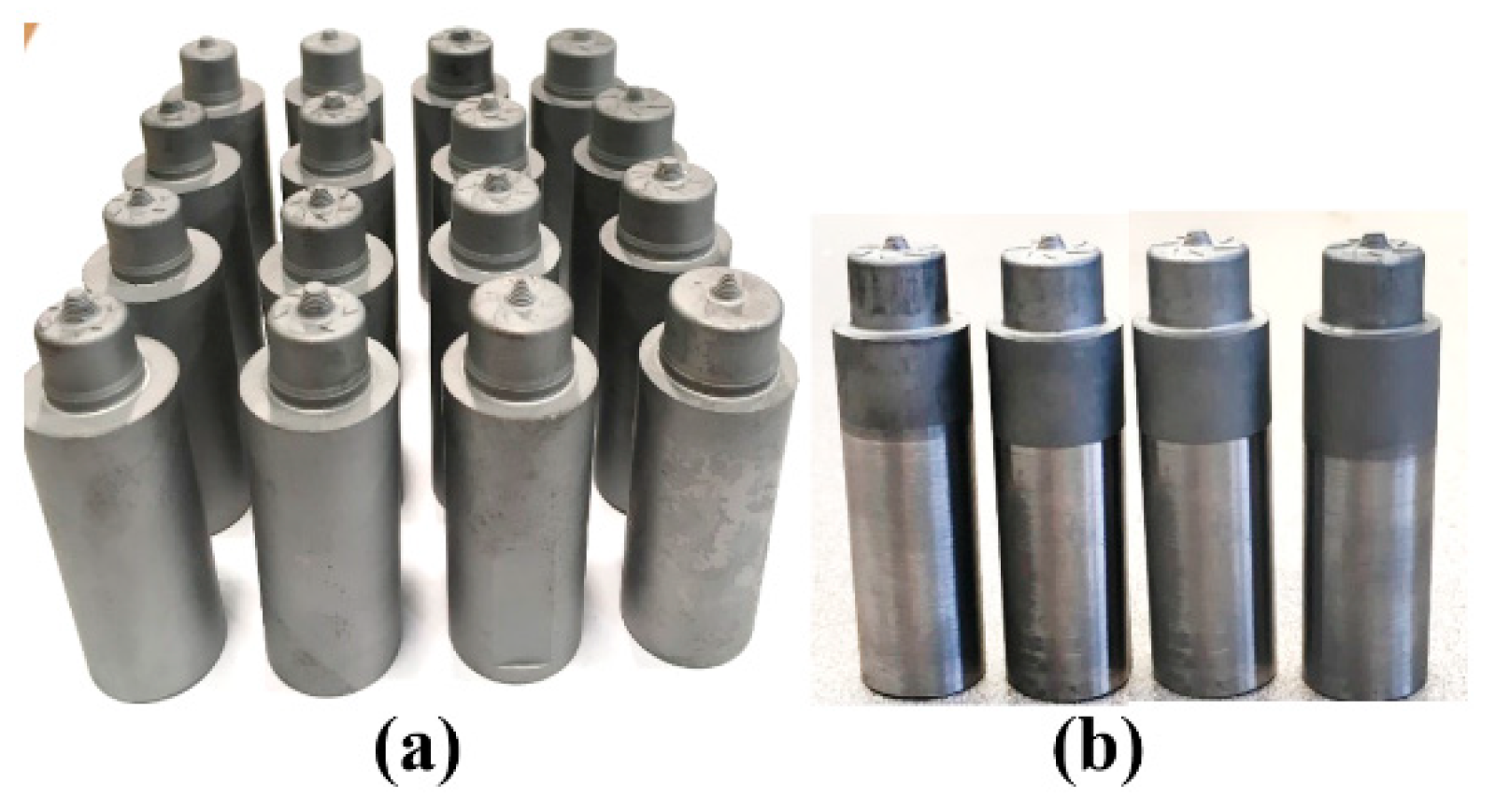



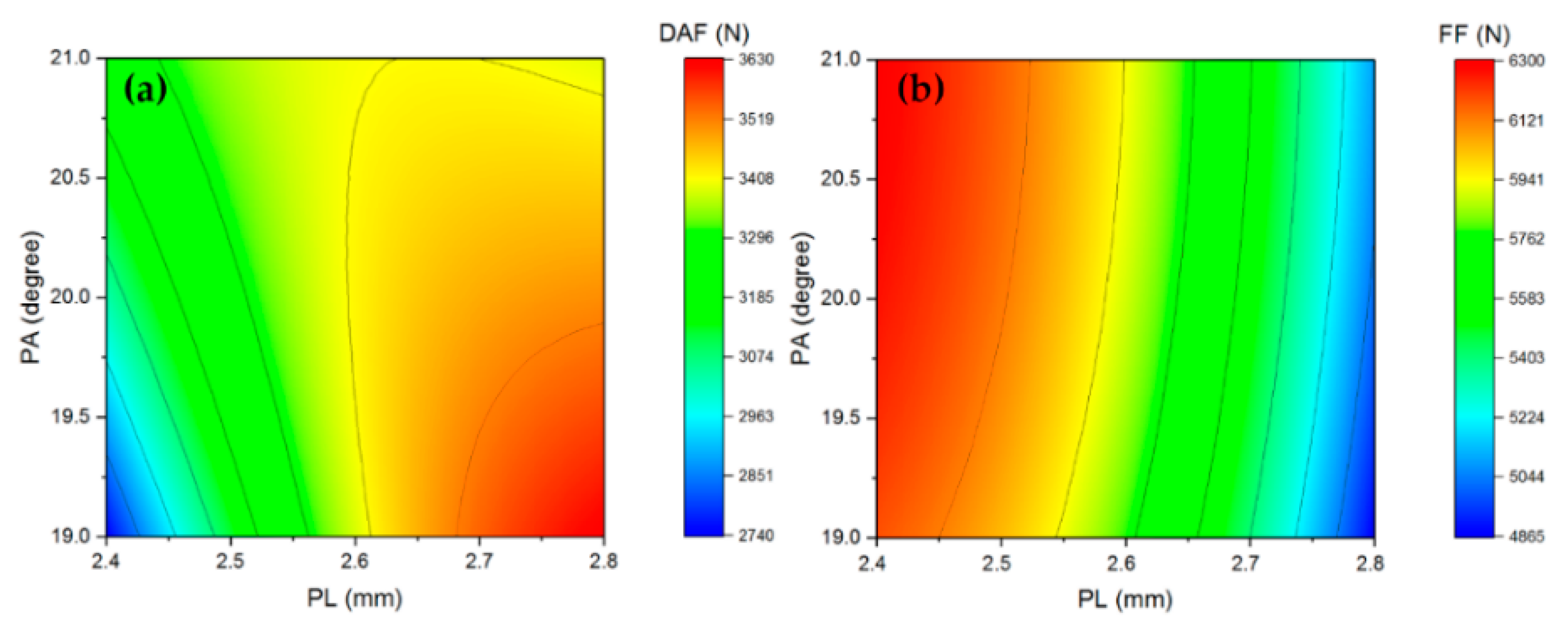
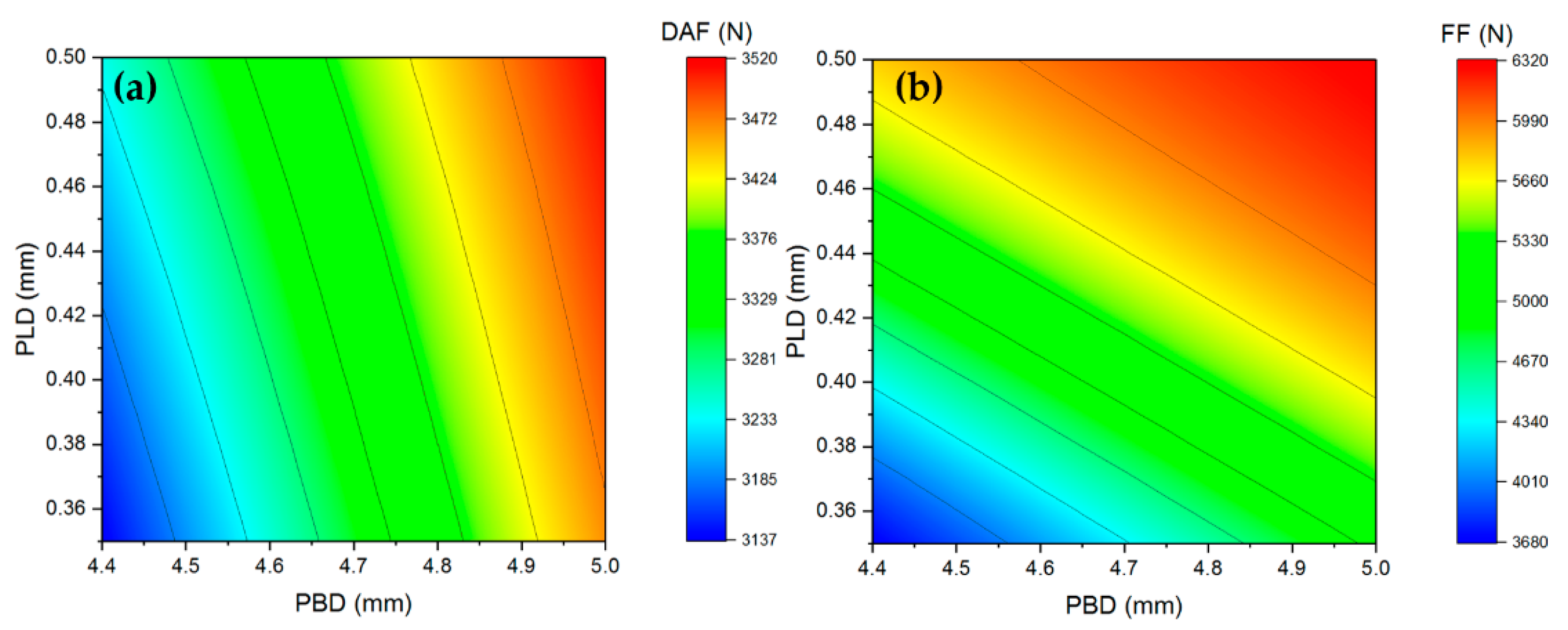

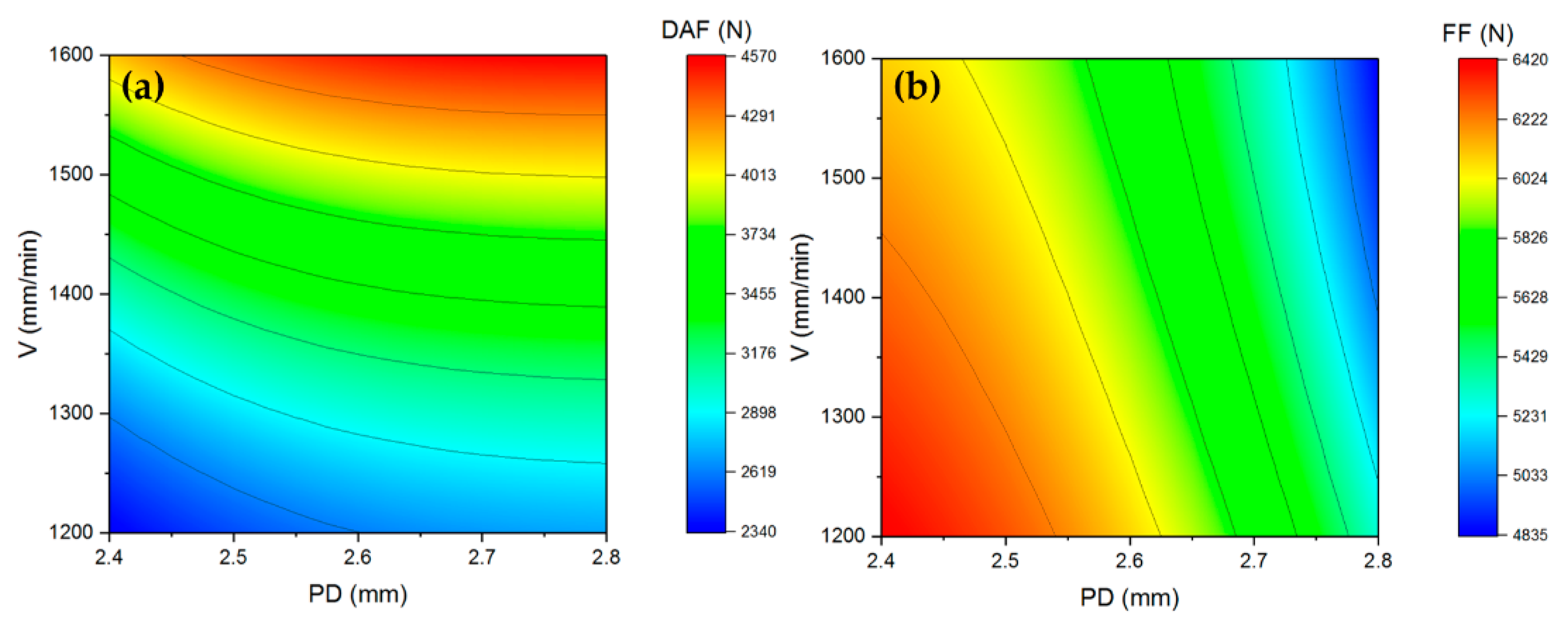
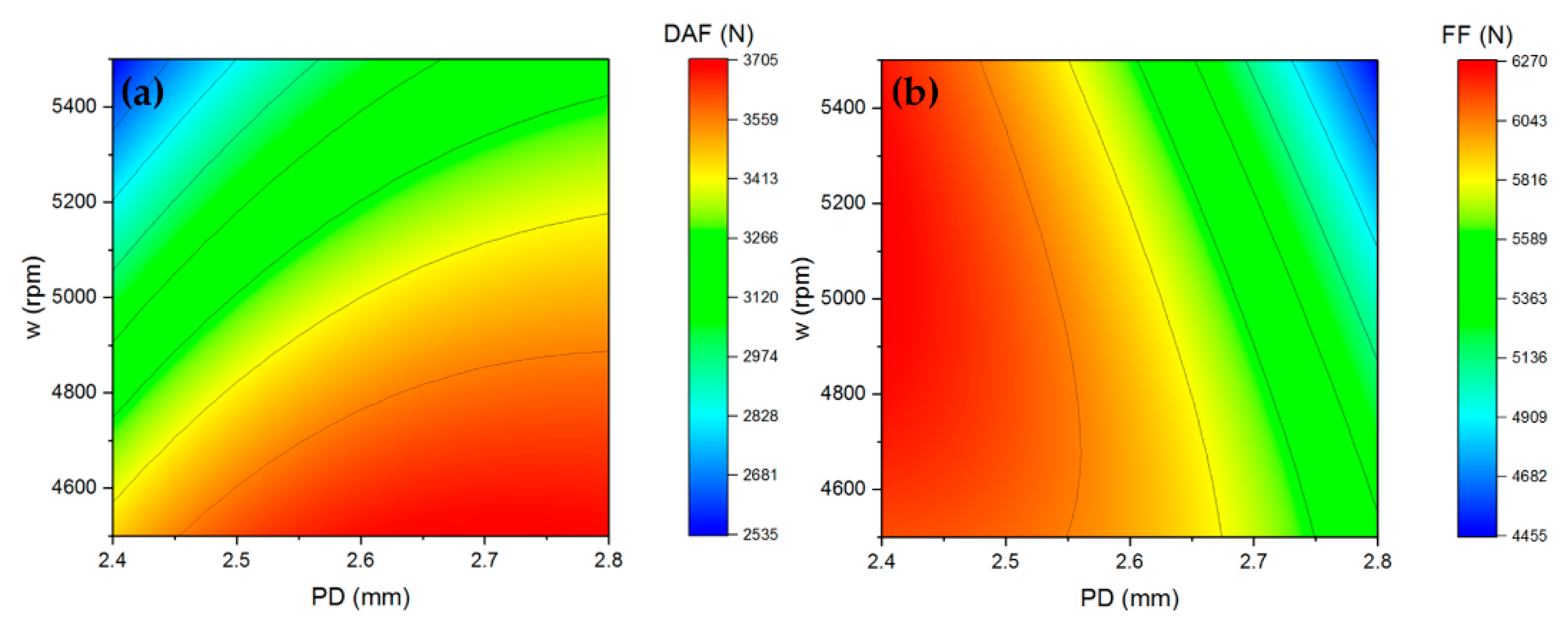
| Chemical Composition (wt%) | |||||||
|---|---|---|---|---|---|---|---|
| Material | Al | Mg | Mn | Cu | Fe | Si | UTS (MPa) |
| AA-6061-T6 | Bal. | 0.83 | 0.07 | 0.19 | 0.19 | 0.55 | 285 |
| Sample No. | Sample Code | PL (mm) | SD (mm) | SGD (mm) | PBD (mm) | PA (°) | PLD (mm) | V (mm/min) | w (rpm) | PD (mm) | C | DAF (N) | FF (N) |
|---|---|---|---|---|---|---|---|---|---|---|---|---|---|
| 1 | 1-a | 1.8 | 8.5 | 0.1 | 4 | 20 | 0.25 | 1400 | 3500 | 1.8 | 1 | 2600 | 2994 |
| 2 | 1-b | 1.8 | 8.5 | 0.1 | 4 | 20 | 0.25 | 1400 | 3500 | 1.85 | 1 | 3060 | 4453 |
| 3 | 2-a | 1.8 | 9.5 | 0.1 | 4 | 20 | 0.45 | 2000 | 5000 | 1.8 | 2 | 2500 | 3390 |
| 4 | 2-b | 1.8 | 9.5 | 0.1 | 4 | 20 | 0.45 | 2000 | 5000 | 1.85 | 2 | 3120 | 3937 |
| 5 | 3-a | 1.8 | 10.5 | 0.25 | 4.8 | 24 | 0.25 | 1400 | 3500 | 1.8 | 2 | 2900 | 5373 |
| 6 | 3-b | 1.8 | 10.5 | 0.25 | 4.8 | 24 | 0.25 | 1400 | 3500 | 1.88 | 2 | 4130 | 5422 |
| 7 | 4-a | 1.8 | 11.5 | 0.25 | 4.8 | 24 | 0.45 | 2000 | 5000 | 1.8 | 1 | 2810 | 2847 |
| 8 | 4-b | 1.8 | 11.5 | 0.25 | 4.8 | 24 | 0.45 | 2000 | 5000 | 1.88 | 1 | 4320 | 5218 |
| 9 | 5-a | 2.2 | 8.5 | 0.1 | 4.8 | 24 | 0.25 | 2000 | 5000 | 2.2 | 2 | 3210 | 3510 |
| 10 | 5-b | 2.2 | 8.5 | 0.1 | 4.8 | 24 | 0.25 | 2000 | 5000 | 2.25 | 2 | 3590 | 3390 |
| 11 | 6-a | 2.2 | 9.5 | 0.1 | 4.8 | 24 | 0.45 | 1400 | 3500 | 2.2 | 1 | 3420 | 5218 |
| 12 | 6-b | 2.2 | 9.5 | 0.1 | 4.8 | 24 | 0.45 | 1400 | 3500 | 2.25 | 1 | 4000 | 5609 |
| 13 | 7-a | 2.2 | 10.5 | 0.25 | 4 | 20 | 0.25 | 2000 | 5000 | 2.2 | 1 | 3200 | 4502 |
| 14 | 7-b | 2.2 | 10.5 | 0.25 | 4 | 20 | 0.25 | 2000 | 5000 | 2.28 | 1 | 3840 | 5756 |
| 15 | 8-a | 2.2 | 11.5 | 0.25 | 4 | 20 | 0.45 | 1400 | 3500 | 2.2 | 2 | 3310 | 2709 |
| 16 | 8-b | 2.2 | 11.5 | 0.25 | 4 | 20 | 0.45 | 1400 | 3500 | 2.28 | 2 | 4530 | 3292 |
| 17 | 9-a | 2.6 | 8.5 | 0.25 | 4 | 24 | 0.45 | 1400 | 5000 | 2.6 | 2 | 2970 | 4083 |
| 18 | 9-b | 2.6 | 8.5 | 0.25 | 4 | 24 | 0.45 | 1400 | 5000 | 2.68 | 2 | 3240 | 3314 |
| 19 | 10-a | 2.6 | 9.5 | 0.25 | 4 | 24 | 0.25 | 2000 | 3500 | 2.6 | 1 | 4100 | 3358 |
| 20 | 10-b | 2.6 | 9.5 | 0.25 | 4 | 24 | 0.25 | 2000 | 3500 | 2.68 | 1 | 4720 | 4746 |
| 21 | 11-a | 2.6 | 10.5 | 0.1 | 4.8 | 20 | 0.45 | 1400 | 5000 | 2.6 | 1 | 3170 | 6107 |
| 22 | 11-b | 2.6 | 10.5 | 0.1 | 4.8 | 20 | 0.45 | 1400 | 5000 | 2.65 | 1 | 3780 | 5640 |
| 23 | 12-a | 2.6 | 11.5 | 0.1 | 4.8 | 20 | 0.25 | 2000 | 3500 | 2.6 | 2 | 4480 | 2171 |
| 24 | 12-b | 2.6 | 11.5 | 0.1 | 4.8 | 20 | 0.25 | 2000 | 3500 | 2.65 | 2 | 4700 | 2300 |
| 25 | 13-a | 3 | 8.5 | 0.25 | 4.8 | 20 | 0.45 | 2000 | 3500 | 3 | 1 | 4320 | 4982 |
| 26 | 13-b | 3 | 8.5 | 0.25 | 4.8 | 20 | 0.45 | 2000 | 3500 | 3.08 | 1 | 4680 | 6557 |
| 27 | 14-a | 3 | 9.5 | 0.25 | 4.8 | 20 | 0.25 | 1400 | 5000 | 3 | 2 | 2930 | 2123 |
| 28 | 14-b | 3 | 9.5 | 0.25 | 4.8 | 20 | 0.25 | 1400 | 5000 | 3.08 | 2 | 3360 | 2042 |
| 29 | 15-a | 3 | 10.5 | 0.1 | 4 | 24 | 0.45 | 2000 | 3500 | 3 | 2 | 3934 | 2136 |
| 30 | 15-b | 3 | 10.5 | 0.1 | 4 | 24 | 0.45 | 2000 | 3500 | 3.05 | 2 | 4390 | 2056 |
| 31 | 16-a | 3 | 11.5 | 0.1 | 4 | 24 | 0.25 | 1400 | 5000 | 3 | 1 | 3040 | 3581 |
| 32 | 16-b | 3 | 11.5 | 0.1 | 4 | 24 | 0.25 | 1400 | 5000 | 3.05 | 1 | 3750 | 4141 |
| Sample No. | Sample Code | PL (mm) | SD (mm) | SGD (mm) | PBD (mm) | PA (°) | PLD (mm) | V (mm/min) | w (rpm) | PD (mm) | C | DAF (kN) | FF (kN) |
|---|---|---|---|---|---|---|---|---|---|---|---|---|---|
| 33 | 17-a | 1.8 | 8.5 | 0.1 | 3.5 | 20 | 0.25 | 1700 | 4250 | 1.8 | 1 | 2970 | 3118 |
| 34 | 17-b | 1.8 | 8.5 | 0.1 | 3.5 | 20 | 0.25 | 1700 | 4250 | 1.835 | 1 | 3320 | 3982 |
| 35 | 18-a | 1.75 | 12 | 0.3 | 5 | 25 | 0.5 | 1800 | 4500 | 1.75 | 2 | 2760 | 5454 |
| 36 | 18-b | 1.75 | 12 | 0.3 | 5 | 25 | 0.5 | 1800 | 4500 | 1.83 | 2 | 4320 | 5961 |
| 37 | 19-a | 1.75 | 12 | 0.3 | 4.5 | 25 | 0.35 | 2200 | 5000 | 1.75 | 1 | 3340 | 2224 |
| 38 | 19-b | 1.75 | 12 | 0.3 | 4.5 | 25 | 0.35 | 2200 | 5000 | 1.83 | 1 | 4600 | 4043 |
| 39 | 20-a | 1.75 | 11.5 | 0.3 | 4.5 | 25 | 0.45 | 2400 | 5500 | 1.75 | 2 | 3020 | 4328 |
| 40 | 20-b | 1.75 | 11.5 | 0.3 | 4.5 | 25 | 0.45 | 2400 | 5500 | 1.83 | 2 | 4000 | 4582 |
| Welding Force Model | Failure Force Model | |
|---|---|---|
| Network configuration | 10-8-1 | 10-8-1 |
| Number of inputs | 10 | 10 |
| Number of hidden layers | 1 | 1 |
| Number of neurons | 8 | 8 |
| Number of outputs | 1 | 1 |
| Total no. of experimental data | 40 | 40 |
| Learning rate | 0.5 | |
| Momentum | 0.5 | |
| Method | Back propagation algorithm | |
| Training Data | Confirmation Data | All Data | |||||||||
|---|---|---|---|---|---|---|---|---|---|---|---|
| Downward axial force | Failure force | Downward axial force | Failure force | Downward axial force | Failure force | ||||||
| RMSE | Max E. | RMSE | Max E. | RMSE | Max E. | RMSE | Max E. | RMSE | Max E. | RMSE | Max E. |
| 15.97 | 52 | 71.49 | 211 | 135.76 | 169 | 129.53 | 174 | 45.53 | 169 | 80.96 | 211 |
| RSME | MAE | MRE | Maximum Error | |
|---|---|---|---|---|
| Formula | ||||
| Downward axial force model | 45.53 | 21.61 | 0.64% | 169 |
| Failure force model | 80.96 | 61.85 | 1.73% | 211 |
| R2 (For Training Data) | R2 (For Confirmation Tests) | R2 (For All Data) | |
|---|---|---|---|
| Downward axial force model | 0.999981092 | 0.998622385 | 0.999846253 |
| Failure force model | 0.999722461 | 0.998734858 | 0.999634318 |
| Sample No. | Measured Downward Axial Force (N) | Predicted Downward Axial Force (N) | Error of Model for Downward Axial Force (N) | Measured Failure Force (N) | Predicted Failure Force (N) | Error of Model for Failure Force (N) |
|---|---|---|---|---|---|---|
| 15 | 3310 | 3479 | 5% | 2709 | 2810 | 3.7% |
| 20 | 4720 | 4553 | 3.5% | 4746 | 4876 | 2.7% |
| 27 | 2930 | 3050 | 4.1% | 2123 | 2025 | 4.6% |
| 34 | 3320 | 3373 | 1.6% | 3982 | 4156 | 4.4% |
| PL (mm) | SD (mm) | SGD (mm) | PBD (mm) | PA (°) | PLD (mm) | V (mm/min) | W (rpm) | PD (mm) | C |
|---|---|---|---|---|---|---|---|---|---|
| 2.5–2.65 | 9.5–10.5 | 0.09–0.12 | 4.7–4.9 | 19–20 | 0.44–0.46 | 1200–1450 | 4500–5200 | 2.5–2.65 | 1 |
© 2019 by the authors. Licensee MDPI, Basel, Switzerland. This article is an open access article distributed under the terms and conditions of the Creative Commons Attribution (CC BY) license (http://creativecommons.org/licenses/by/4.0/).
Share and Cite
Momeni, M.; Guillot, M. Effect of Tool Design and Process Parameters on Lap Joints Made by Right Angle Friction Stir Welding (RAFSW). J. Manuf. Mater. Process. 2019, 3, 66. https://doi.org/10.3390/jmmp3030066
Momeni M, Guillot M. Effect of Tool Design and Process Parameters on Lap Joints Made by Right Angle Friction Stir Welding (RAFSW). Journal of Manufacturing and Materials Processing. 2019; 3(3):66. https://doi.org/10.3390/jmmp3030066
Chicago/Turabian StyleMomeni, Mahboubeh, and Michel Guillot. 2019. "Effect of Tool Design and Process Parameters on Lap Joints Made by Right Angle Friction Stir Welding (RAFSW)" Journal of Manufacturing and Materials Processing 3, no. 3: 66. https://doi.org/10.3390/jmmp3030066
APA StyleMomeni, M., & Guillot, M. (2019). Effect of Tool Design and Process Parameters on Lap Joints Made by Right Angle Friction Stir Welding (RAFSW). Journal of Manufacturing and Materials Processing, 3(3), 66. https://doi.org/10.3390/jmmp3030066





